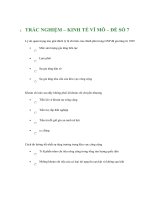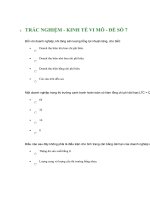KINH TẾ VI MÔ 2015 chapter 7 micro 1 5 public goods
Bạn đang xem bản rút gọn của tài liệu. Xem và tải ngay bản đầy đủ của tài liệu tại đây (621.94 KB, 5 trang )
12/21/2015
Microeconomics
Externalities and Public Goods
Chapter 7
By Tran Thi Kieu Minh, MSc
3
Externalities
• The uncompensated impact of one person’s actions
on the well-being of a bystander
• Market failure
• Negative externality: Impact on the bystander is
adverse
▫ Exhaust from automobiles
▫ Barking dogs
• Positive externality: Impact on the bystander is
beneficial
▫ Restored historic buildings
▫ Research into new technologies
4
Externalities and Market Inefficiency
• Externalities
Cause markets to allocate resources inefficiently
• Welfare economics: a recap
▫ Demand curve – value to consumers
Prices they are willing to pay
▫ Supply curve – cost to suppliers
▫ Equilibrium quantity and price
Efficient
Maximizes sum of producer & consumer surplus
1
12/21/2015
6
The market for aluminum
Price of
Aluminum
Externalities and Market Inefficiency
Supply
(private cost)
• Negative externalities
▫ Pollution
▫ Cost to society (of producing aluminum)
Equilibrium
Larger than the cost to the aluminum producers
▫ Social cost - supply
Demand
(private value)
0
Private costs of the producers
Plus the costs to those bystanders affected adversely
by the negative externality
Quantity of
Aluminum
QMARKET
The demand curve reflects the value to buyers, and the supply curve reflects the costs
of sellers. The equilibrium quantity, QMARKET, maximizes the total value to buyers minus
the total costs of sellers. In the absence of externalities, therefore, the market
equilibrium is efficient.
▫ Social cost curve – above the supply curve
5
8
Pollution and the social optimum
Price of
Aluminum
External
Cost
Externalities and Market Inefficiency
Social cost (private cost
and external cost)
Supply
(private cost)
• Positive externalities
▫ Education
Optimum
Benefit of education – private
Externalities: better government, lower crime rate,
higher productivity and wages
Equilibrium
Demand
(private value)
0
QOPTIMUM
QMARKET
▫ Social value – demand
Higher than private value
Quantity of
Aluminum
In the presence of a negative externality, such as pollution, the social cost of the good
exceeds the private cost. The optimal quantity, QOPTIMUM, is therefore smaller than the
equilibrium quantity, QMARKET.
▫ Social value curve
Above demand curve
7
2
12/21/2015
10
Education and the social optimum
Price of
Aluminum
Optimum
Externalities and Market Inefficiency
Supply
(private cost)
External
Benefit
Equilibrium
Social value
(private value
and external benefit)
• Government – correct market failure
▫ Taxing goods that have negative externalities
▫ Subsidizing goods that have positive externalities
Demand
(private value)
0
QMARKET QOPTIMUM
Quantity of
Aluminum
In the presence of a positive externality, the social value of the good exceeds the private
value. The optimal quantity, QOPTIMUM, is therefore larger than the equilibrium quantity,
QMARKET.
9
12
The Different Kinds of Goods
• Excludability
▫ Property of a good
▫ A person can be prevented from using it
• Rivalry in consumption
▫ Property of a good
▫ One person’s use diminishes other people’s use
3
12/21/2015
14
Four types of goods
The Different Kinds of Goods
Rival in consumption?
Yes
Yes
Excludable?
No
No
Private goods
Natural monopolies
- Ice-cream cones
- Clothing
- Congested toll roads
- Fire protection
- Cable TV
- Uncongested toll roads
Common resources
Public goods
▫ Public goods
- Fish in the ocean
- The environment
- Congested nontoll roads
- Tornado system
- National defense
- Uncongested nontoll roads
▫ Common resources
Goods can be grouped into four categories according to two characteristics:
(1) A good is excludable if people can be prevented from using it.
(2) A good is rival in consumption if one person’s use of the good diminishes other
people’s use of it.
This diagram gives examples of goods in each category.
• Types of goods
▫ Private goods
Excludable & Rival in consumption
Not excludable & Not rival in consumption
Rival in consumption & Not excludable
▫ Natural monopoly
Excludable & Not rival in consumption
13
15
The Different Kinds of Goods
• Public goods & Common resources
▫ Not excludable
▫ People cannot be prevented from using them
▫ No price attached to it
▫ Positive externalities
▫ Negative externalities
16
Public Goods
• The free-rider problem
▫ Free rider
Person who receives the benefit of a good but avoids paying
for it
▫ Public goods – not excludable
Free-rider problem prevents the private market from
supplying the goods
Government - can remedy the problem
If total benefits of a public good > its costs
Provide the public good
Pay for it with tax revenue
Make everyone better off
4
12/21/2015
17
Public Goods
18
Public Goods
• Some important public goods
▫ National defense
• The difficult job of cost–benefit analysis
▫ Government
Very expensive public good
Decide what public goods to provide
In what quantities
▫ Basic research
▫ Cost–benefit analysis
General knowledge
Compare the costs and benefits to society of
providing a public good
Doesn’t have any price signals to observe
Government findings on the costs and benefits
▫ Fighting poverty
Welfare system
Food stamps
Rough approximations at best
19
Common Resources
• Common resources
▫ Not excludable
▫ Rival in consumption
• Some important common resources
▫ Clean air and water
▫ Congested roads
▫ Fish, whales, and other wildlife
20
Common Resources
• The tragedy of the commons
▫ Parable - why common resources are used more than
desirable
From society’s standpoint
▫ Social and private incentives differ
▫ Arises because of a negative externality
▫ Negative externality
One person uses a common resource
Diminishes other people’s enjoyment of it
Common resources tend to be used excessively
▫ Government - can solve the problem
Regulation or taxes
Reduce consumption of the common resource
Turn the common resource into a private good
5









